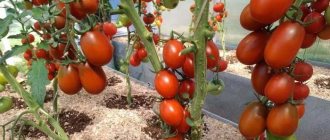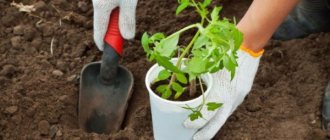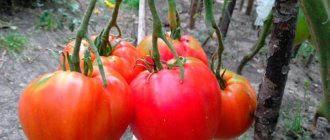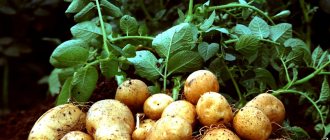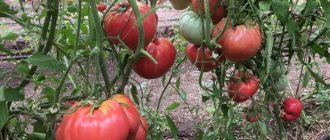Tomato “De Barao Tsarsky”: description of the variety
| Variety name | De Barao Tsarsky |
| general description | Mid-season indeterminate variety |
| Originator | Brazil |
| Ripening period | 110-120 days |
| Form | Elongated, with a small nose |
| Color | Red |
| Average weight of tomatoes | 150-170 grams |
| Application | Universal |
| Productivity of the variety | 10-15 kg per bush |
| Features of cultivation | Standard agricultural technology |
| Disease resistance | Has excellent immunity |
This variety is an indeterminate, non-standard plant.
That is, new branches grow gradually, thereby ensuring a long period of fruiting. The ripening time is average. The height of the plant can reach very large sizes of 1.5 - 2 meters, so its powerful stem requires good support and tying. It is best to use trellises. The variety can be grown in open ground or in greenhouses. The plant's immunity is quite good. The yield of the variety is high; from one large plant you can get 10-15 kg . Under good conditions and regular feeding, the yield can be increased to 20 kg.
Tomato "De Barao Tsarsky" has many advantages:
- high yield;
- beautiful presentation;
- fruits are stored for a long time;
- have good ripening ability;
- long fruiting until the first frost;
- endurance and excellent immunity;
- widespread use of the finished crop.
Disadvantages of this type:
- due to high growth, it requires a lot of space;
- mandatory powerful support;
- requires mandatory competent stepsoning.
You can compare the yield of this variety with others in the table:
| Variety name | Productivity |
| De Barao Tsarsky | 10-15 kg per bush |
| Soyuz 8 | 15-19 kg per square meter |
| Aurora f1 | 13-16 kg per square meter |
| Red Dome | 17 kg per square meter |
| Aphrodite f1 | 5-6 kg per bush |
| King of the Early | 12-15 kg per square meter |
| Severenok f1 | 3.5-4 kg per bush |
| Ob domes | 4-6 kg per bush |
| Katyusha | 17-20 kg per square meter |
| Pink fleshy | 5-6 kg per square meter |
Seedling care
The seedlings are cared for as usual, avoiding flooding, ventilating and feeding. They dive, if necessary, additionally illuminate and harden before planting in the ground. Holes are dug rarely, about 2-3 per square meter, so that the bushes are well ventilated and convenient to maintain.
Caring for plantings is no more difficult than working with classic domestic varieties. Abundant and infrequent watering at the root with heated water, weeding and loosening are liked by all varieties. The main difficulty is the need to install strong, high trellises and regularly tie stems and brushes to them.
To maintain health, preventive spraying with fungicides should be carried out; copper solutions are most often used for these purposes. Spraying with wood ash, which contains the potassium necessary for plants, helps prevent blossom end rot.
Fertilizing is needed with both organic matter and mineral fertilizers with the addition of microelements. The described varieties are sensitive to the presence of superphosphate, so it should be added both to the planting holes and subsequently as an extract at the stage of fruit set and growth.
Experienced gardeners pay attention to crop rotation, and to disinfect the soil in the intervals between growing vegetable crops, they sow green manure.
When forming such powerfully growing plants, the stepsons should be removed once a week, leaving a small stump. It is best to do this with your fingers so as not to introduce an infection with the tool. 1-2 stems are left for fruiting.
An enviable harvest of yellow and pink varieties in the video:
Characteristics
Description of fruits:
- 8-10 clusters are formed on each stem.
- Each of them has about 7-8 fruits.
- The tomatoes are slightly elongated in shape, pinkish-red.
- The weight of the fruit ranges from 150 to 170 g. This is one of the largest in the De Barao family.
- The taste of the fruit is pleasant, juicy and fleshy.
- There are 2 chambers inside the fetus.
- The amount of dry matter is 4-5%.
- The fruits have a beautiful presentation and are stored for a long time.
- The variety ripens well if the green fruits are collected.
De Barao Tsarskiy tomatoes are perfect for canning and pickling. They are good to use fresh, in salads and first courses. Good to use dried. These tomatoes make wonderful tasty tomato juice and thick paste.
You can compare the weight of the fruits of this variety with others in the table:
| Variety name | Fruit weight |
| De Barao Tsarsky | 150-170 grams |
| Argonaut f1 | 180 grams |
| The Lazy Man's Miracle | 60-65 grams |
| Locomotive | 120-150 grams |
| Shchelkovsky early | 40-60 grams |
| Katyusha | 120-150 grams |
| Bullfinch | 130-150 grams |
| Anyuta f1 | 95-120 grams |
| F1 debut | 180-250 grams |
| White filling 241 | 100g |
Outdoor care
If you follow all the rules of agricultural technology, you can get strong and beautiful bushes that bring a high yield.
Watering
You only need to irrigate tomatoes with settled water using a sprayer.
Watering should be done every 3-4 days. 8-10 liters of water are needed per 1 m2.
And although tomatoes are moisture-loving plants, waterlogging is not permissible. This is fraught with rotting of the roots.
Attention! Since “Da Barao” is a tall variety, watering should be done at the root.
Transfer
If the seedlings were sown in March, then at the end of May they can be transplanted into open ground. Before this, harden the seedlings by taking them outside every day. Plant seedlings in the garden in early June.
To do this, prepare the holes, placing them at a distance of 90 cm. Place humus or compost there. This will speed up the process of plant establishment.
Fertilizer and feeding
In total, during the growing season, fertilizing is used 2 times:
- Carry out the first fertilizing in early June. To obtain a solution, take 10 liters of water, 500 ml of mullein, 2 tablets of microfertilizers, 20 g of nitrophoska, 5 g of boric acid. 1 plant requires 1 liter of solution.
- The second feeding is carried out in early July. Take 10 liters of water, 500 ml of mullein, 2 tablets of microfertilizers, 20 g of potassium sulfate. 1 plant requires 1 liter of solution.
Features of cultivation
“De Barao Tsarsky” tolerates frost well and is not afraid of temperature changes. Therefore, the variety is successfully grown in almost all regions. In the Rostov, Astrakhan, Belgorod regions, the Caucasus and Crimea, it is better to grow in open ground. In the Far East and in regions of Siberia, it is necessary to grow only in greenhouses.
You also need to take into account that this tomato needs good support; without it, the yield can decrease significantly. “De Barao Tsarsky” is very unpretentious and with good support grows to a gigantic size of about 2 meters. The plant tolerates shade and temperature changes well.
Forms beautiful rich clusters of fruits that require garter. The plant responds well to fertilizing with mineral fertilizers. During active growth, abundant watering is needed. In some regions, obtaining seeds can be difficult, especially in the northern regions.
Read on our website how to properly grow large tomatoes, along with cucumbers, along with peppers, and how to grow good seedlings for this. And also methods for growing tomatoes in two roots, in bags, without picking, in peat tablets.
Advantages and disadvantages
Experienced gardeners always have the De Barao tomato variety in their greenhouses. This is because it has a number of advantages:
- not capricious, not demanding of care;
- excellent yield;
- tolerates partial shade;
- frost-resistant;
- tomatoes can be stored after picking for up to two months;
- tolerates drought well;
- even an inexperienced gardener can grow it;
- a very disease-resistant variety.
This variety has practically no disadvantages. Sometimes it is affected by fungal diseases.
Diseases and pests
The plant has good immunity to late blight. To prevent fungal diseases and fruit rot, greenhouses must be regularly ventilated and the correct light and temperature conditions must be maintained.
Among the harmful insects it can be affected by melon aphids and thrips, the drug “Zubr” is successfully used against them. Mole crickets and slugs can also cause great damage to these bushes. They are combated by loosening the soil, and also using dry mustard or hot ground pepper diluted in water, a 10-liter spoon, and watering the soil around.
Video
Next, you can watch a video review of the harvest of tomatoes of the “De Barao Tsarskiy” variety:
| Super early | Mid-early | Late ripening |
| Alpha | King of the Giants | Premier |
| Pickling miracle | Supermodel | Grapefruit |
| Labrador | Budenovka | Yusupovsky |
| Bullfinch | Bear Paw | Rocket |
| Sollerosso | Danko | Digitomandra |
| Debut | King Penguin | Rocket |
| Alenka | emerald apple | Snowfall F1 |





